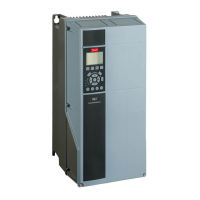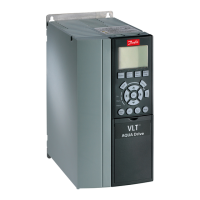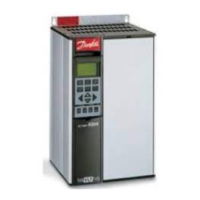I/O mode and parameter group 3-1*
References.
Possible incorrect parameter
settings.
Check the settings of all motor pa-
rameters, including all motor com-
pensation settings. For closed-loop
operation, check PID settings.
Check settings in parameter group 1-6*
Load Depen. Setting. For closed-loop
operation, check settings in parameter
group 20-0* Feedback.
Possible overmagnetization.
Check for incorrect motor settings
in all motor parameters.
Check motor settings in parameter
groups 1-2* Motor data, 1-3* Adv Motor
Data, and 1-5* Load Indep. Setting.
Possible incorrect settings in
the brake parameters. Ramp-
down times may be too short.
Check brake parameters. Check
ramp time settings.
Check parameter groups 2-0* DC Brake
and 3-0* Reference Limits.
Motor or panel has a short phase-
to-phase. Check motor and panel
phases for shorts.
Eliminate any shorts detected.
Motor is overloaded for the appli-
cation.
Perform start-up test and verify that
motor current is within specifications.
If motor current is exceeding the
nameplate full load current, the motor
can run only with reduced load. Re-
view the specifications for the applica-
tion.
Perform pre-start-up check for
loose connections.
Tighten loose connections.
Mains current
imbalance
greater than 3%
Problem with mains power
(see Alarm 4, Mains phase loss
description).
Rotate input power leads into the
AC drive 1 position: A to B, B to C, C
to A.
If imbalanced leg follows the wire, it is
a power problem. Check the mains
supply.
Problem with the AC drive.
Rotate input power leads into the
AC drive 1 position: A to B, B to C, C
to A.
If the imbalanced leg stays on same in-
put terminal, it is a problem with the
AC drive. Contact the supplier.
Motor current
imbalance
greater than 3%
Problem with motor or motor
wiring.
Rotate output motor cables 1 posi-
tion: U to V, V to W, W to U.
If the imbalanced leg follows the wire,
the problem is in the motor or motor
wiring. Check motor and motor wiring.
Rotate output motor cables 1 posi-
tion: U to V, V to W, W to U.
If the imbalanced leg stays on same
output terminal, it is a problem with
the unit. Contact the supplier.
AC drive accel-
eration prob-
lems
Motor data are entered incor-
rectly.
If warnings or alarms occur, refer to
the Warnings and Alarms section.
Check that motor data are entered
correctly.
Increase the ramp-up time in parame-
ter 3-41 Ramp 1 Ramp Up Time. In-
crease current limit in parameter 4-18
Current Limit. Increase torque limit in
parameter 4-16 Torque Limit Motor
Mode.
AC drive decel-
eration prob-
lems
Motor data are entered incor-
rectly.
If warnings or alarms occur, refer to
the Warnings and Alarms section.
Check that motor data are entered
correctly.
Increase the ramp-down time in pa-
rameter 3-42 Ramp 1 Ramp Down Time.
Enable overvoltage control in parame-
ter 2-17 Over-voltage Control.
AQ262141314214en-000301 / 130R0880 | 153Danfoss A/S © 2021.11
Maintenance, Diagnostics, and
Troubleshooting
VLT® HVAC Drive FC 102
Operating Guide
